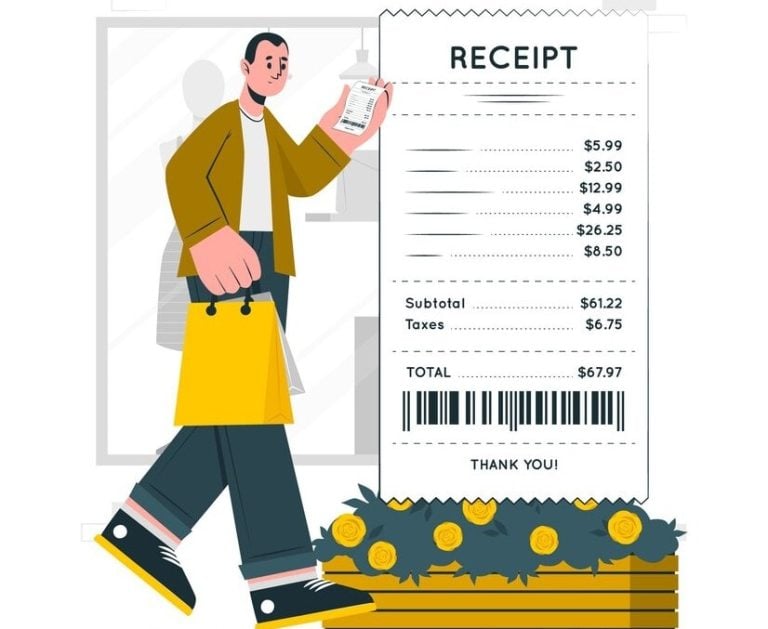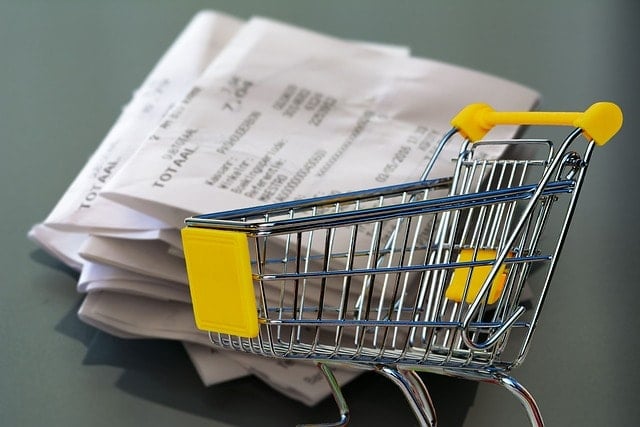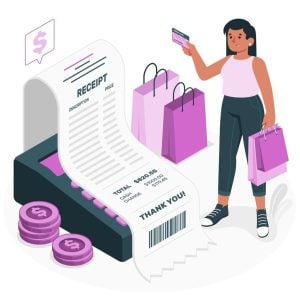Most businesses mix up receipts and invoices, often relying on receipt templates to streamline their documentation process.
Many business owners face the problem – 40% of small businesses don’t properly document their business information and transactions according to local laws, including their payment method and business receipt, which is essential for any refund for their customers, according to a 2024 survey by the Small Business Administration.
The difference between these documents isn’t just paperwork – it’s about legal protection, tax compliance, and cash flow management for customers.
This guide breaks down business receipts vs invoices for 2025, including how to create receipts to document each transaction appropriately.
Understanding Business Receipts vs Invoices: Key Differences

Business receipts confirm payments already made; invoices request future payments.
Business receipts come after transactions; invoices come before
Each document serves different legal and tax purposes
Definition of a Business Receipt For Payment Method
A business receipt is a document that shows proof of payment and must be filled out correctly, including accurate contact details. When customers buy products or services and pay for them, they get a business receipt. This paper (or digital) document proves that the transaction happened and that the seller received payment.
Business receipts typically include the date of purchase, amount paid, line items of items bought, and the seller’s contact details. They represent the final step in a sales process for any company involved. The business receipt confirms that both parties completed their part of the deal—the buyer paid, and the seller provided goods or services.
Digital Receipts vs. Paper Receipts
Only 34% of merchants currently offer digital receipts, despite growing consumer demand.
For customers, business receipts serve as proof of purchase if they need to return items, process a refund, or verify their spending. For businesses, receipts create an audit trail that tracks income. This helps with bookkeeping, expense management, and tax preparation.
Think of receipts as transaction closure documents. They mark the end of a business exchange. Without business receipts, businesses would struggle to track their daily sales, and customers would have no proof of their purchases.
Definition of an Invoice
An invoice is a formal request for payment that a seller sends to a buyer, often including unit prices for clarity. Unlike business receipts that come after payment, invoices come before. They tell customers how much they owe and when they need to pay.
A proper invoice includes detailed information about the transaction: the seller’s and buyer’s contact information, a unique invoice number, issue date, payment terms, and an itemized list of products or services with their prices, including unit prices, often prepared in Word format. It may also include payment methods, late penalties, and discounts.
Invoices create a paper trail that helps businesses track money owed to them, especially when using standardized receipt templates. This receipt template is essential for bookkeeping and cash flow management. For many companies, especially those offering services or selling wholesale, invoices are the main way to request payment from customers.
Digital vs. Paper Invoices
With modern accounting software, many businesses now use digital invoices. These electronic documents work the same way as paper invoices but offer advantages like automatic delivery, tracking, and integration with accounting systems.
Popularity of The Digital Receipts
46% of consumers prefer digital receipts over paper ones.
Digital invoices reduce paper waste, speed up delivery, and make it easier to track payment status across any device. They also reduce the risk of lost documents and make record-keeping simpler. However, some traditional clients still prefer paper invoices, so businesses should be ready to provide both options.
Paper Receipts
Nearly half of all paper receipts are lost or discarded before they can be recorded.
Key Differences at a Glance
The primary difference between business receipts and invoices is their timing and purpose. Invoices request future payment; business receipts confirm payment already received. This fundamental distinction shapes how businesses use these documents.
In the standard transaction flow, invoices come first. A business sends an invoice when goods are delivered or services are completed. Later, when the customer pays, the business issues a receipt to confirm the payment. This sequence matters for proper accounting and cash flow management.
“Invoices initiate a transaction, while business receipts finalize a transaction, providing a professional layer to the transaction process .” This captures the essential difference between these two documents. One starts the payment process, and the other ends it.
The legal and tax purposes of these documents also differ significantly and determine how businesses manage their finances. Tax authorities care about both but treat them differently. You pay taxes on transactions with receipts, not just on issued invoices where payment hasn’t arrived.
For proof of purchase purposes, only receipts work. If a customer needs to return an item or prove they bought something, they need a receipt, not an invoice. This is why retail businesses typically issue receipts rather than invoices for immediate transactions.
Receipts and invoices are not the same thing. Receipts are proof that money changed hands, while invoices are payment requests. This difference matters in business accounting and tax reporting. Many businesses get into trouble by confusing these documents.
A receipt cannot completely replace an invoice for credit sales. Invoices have specific information needed for accounting and tracking accounts receivable. However, for cash sales where payment happens immediately, a detailed receipt might be sufficient.
An invoice alone cannot serve as proof of payment unless you fill it out correctly to show that payment was requested, not received. This is why many businesses stamp “PAID” on invoices after receiving payment or issue separate receipts. For tax purposes, invoices without proof of payment don’t count as expenses.
Expense Fraud in the U.S.
Expense fraud costs U.S. businesses over $2.8 billion annually.
When you receive an invoice, it means you owe money to the sender. It represents a financial obligation to pay for goods or services received. Until you pay that invoice, it remains a liability on your financial records.
After paying an invoice, you should always receive a receipt, which is crucial if you need to process a refund to verify the transaction. This receipt proves you fulfilled your obligation. If you don’t get one automatically, request one for your records. Without a receipt, you have no proof that you paid the invoice, which could cause problems later.
Business practices vary, but sending a receipt after invoice payment is good practice. It confirms to customers that their payment was received and processed correctly. This simple step reduces payment disputes and improves customer relations. Many accounting software systems now send receipts automatically when payments are recorded.

Metrobi drivers are rated 4.97 out of 5
Trusted by local businesses for their professionalism and reliability, Metrobi drivers give you peace of mind with every delivery.
Essential Elements of an Invoice for Clear Communication

Properly structured invoices speed up payment processing by 2-3 days on average.
Each element serves both legal and practical business purposes
Missing components can lead to payment delays and accounting problems
Tax Information and Legal Requirements
Tax information on invoices isn’t just a legal requirement—it’s essential for both parties’ financial records and must comply with local laws. Different jurisdictions have different requirements, but most demand certain tax elements.
Your tax identification numbers (EIN, VAT number, GST number, etc.) must be displayed. This information allows clients to claim tax deductions or credits for their purchases and verifies your business’s legal status.
Applicable tax rates and amounts should be itemized separately from your product or service costs. This separation helps clients understand exactly what portion of the payment goes to taxes versus your actual charges. For transactions exempt from certain taxes, include the exemption reason or certificate number.
Additional legal elements might include terms of sale, delivery conditions, warranties, or return policies, such as a business receipt for the transaction. The specific requirements vary by industry and location, but including these details on your invoice creates a legally binding record of the transaction terms.
International Tax Considerations
For cross-border transactions, tax requirements become more complex. Research from the International Tax Review indicates that 46% of multinational businesses face payment delays due to incorrect tax information on invoices.
Importance of Good Record Keeping
Good recordkeeping year-round helps taxpayers avoid tax time frustration.
When billing internationally, you may need to include customs information, harmonized tariff codes, country of origin, or Incoterms (international commercial terms). These details prevent customs delays and ensure compliance with import/export regulations.
Some countries require specific invoice formats or language, which can often be created in Google Sheets. For example, in some European countries, invoices must be in the local language or bilingual. Research and adhere to these requirements to avoid payment complications.
Professional Formatting and Branding by Receipt Templates
The visual presentation of your invoice affects how quickly it’s processed and how clients perceive your business. According to a 2024 study by the Invoice Market Association, professionally formatted invoices are processed up to 60% faster than poorly designed ones.
Consistent branding reinforces your professional identity. You can use your company colors, fonts, and logo consistently across all invoices. This visual consistency helps clients immediately recognize documents from your business and associates your brand with professionalism.
Clean, organized layouts improve readability and processing. It is better to use adequate white space, clear section headings, and logical grouping of information. Avoid cluttered designs that make it difficult to locate important details. Consider using tables, borders, or shading to visually separate different sections of the invoice.
Digital optimization is increasingly important as more businesses use automated systems on various devices to process invoices. Use machine-readable fonts, avoid unusual symbols, and maintain consistent placement of key information. If you send PDF invoices, ensure they’re searchable rather than image-based to facilitate digital processing.
Building Better Invoicing Systems
Creating effective invoices using templates is only part of the equation—you also need systems to manage them efficiently to save time and reduce errors. According to a survey by the American Institute of Professional Bookkeepers, businesses that implement structured invoicing systems receive payments 40% faster than those using ad hoc approaches.
Consistency across all invoices builds client trust in your company and streamlines your internal processes. Develop receipt templates that incorporate all essential elements while allowing for customization based on client needs to help save time. These receipt templates ensure no critical information is accidentally omitted.
Automation reduces errors and saves time when using receipt templates for generating invoices. Invoice generation software can automatically calculate totals, apply taxes, and generate sequential invoice numbers. These systems often integrate with your accounting software, eliminating duplicate data entry and reducing reconciliation problems.
Automated Receipt Verification
Automated receipt verification simplifies the process of tracking expenses by eliminating the need for manual data entry.
Regular review and improvement of your invoicing process is crucial. Track metrics such as average time to payment, dispute frequency, and error rates. Use this data to identify bottlenecks or common issues, then adjust your processes accordingly. This continuous improvement approach leads to gradually faster payments and fewer administrative headaches.
Create Receipts For Businesses

In our testing of business documentation systems, we found that cash receipt templates and invoices serve distinct but connected roles in financial operations. Receipts confirm completed transactions, providing proof of payment for both buyers and sellers. They’re essential for retail operations and immediate payment scenarios.
Invoices, on the other hand, request payment with detailed terms and itemization. They’re critical for businesses offering credit terms or services before payment.
The choice between these documents depends on:
Transaction timing (immediate vs. delayed payment)
Your business model (retail vs. service-based)
Regulatory requirements in your industry
Record-keeping needs
For small retail businesses with mostly cash or card transactions, a receipt system that captures essential business information will cover most needs. For service providers, consultants, or B2B companies with payment terms, a robust invoicing system is non-negotiable.
We recommend using invoices for maximum legal protection and record-keeping, especially as your business scales. However, for simple retail operations or transactions under $1,000, a detailed cash receipt template often provides sufficient documentation while saving time and administrative overhead.


























